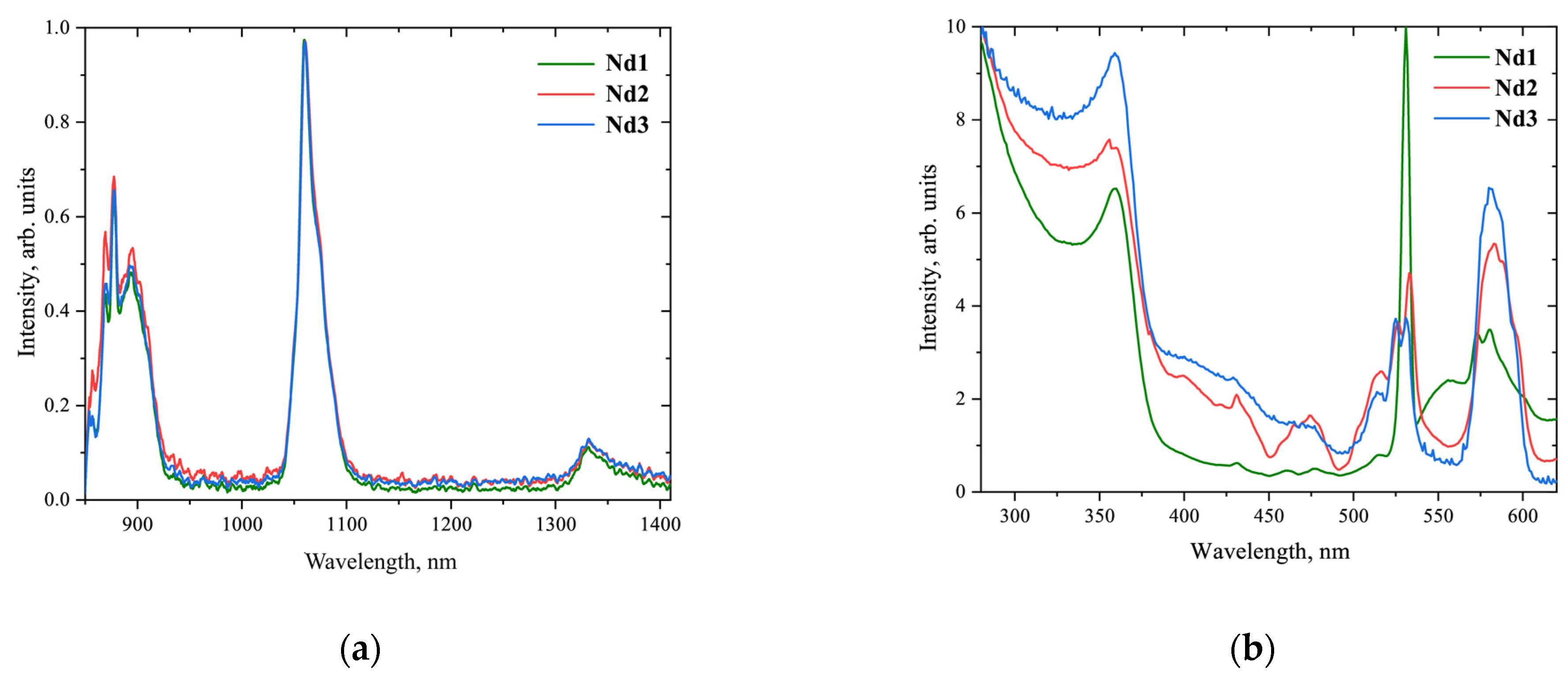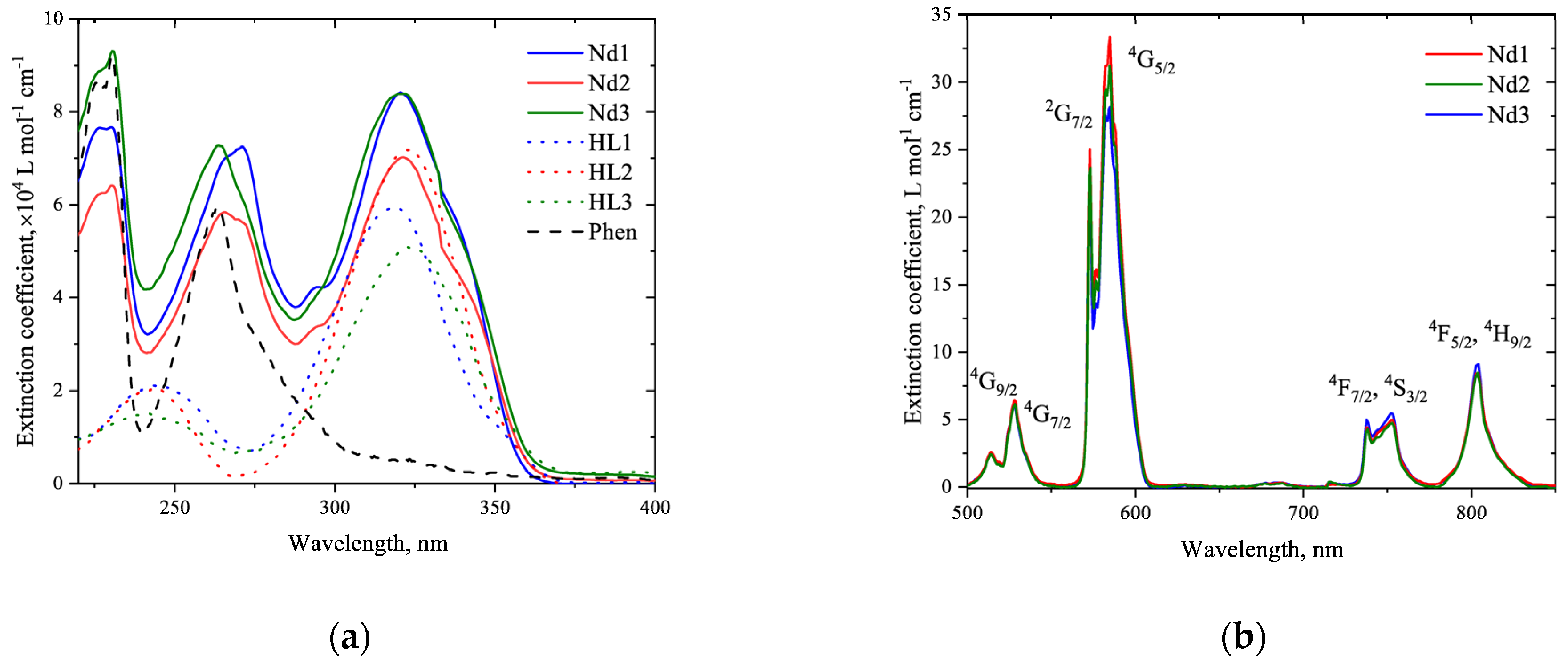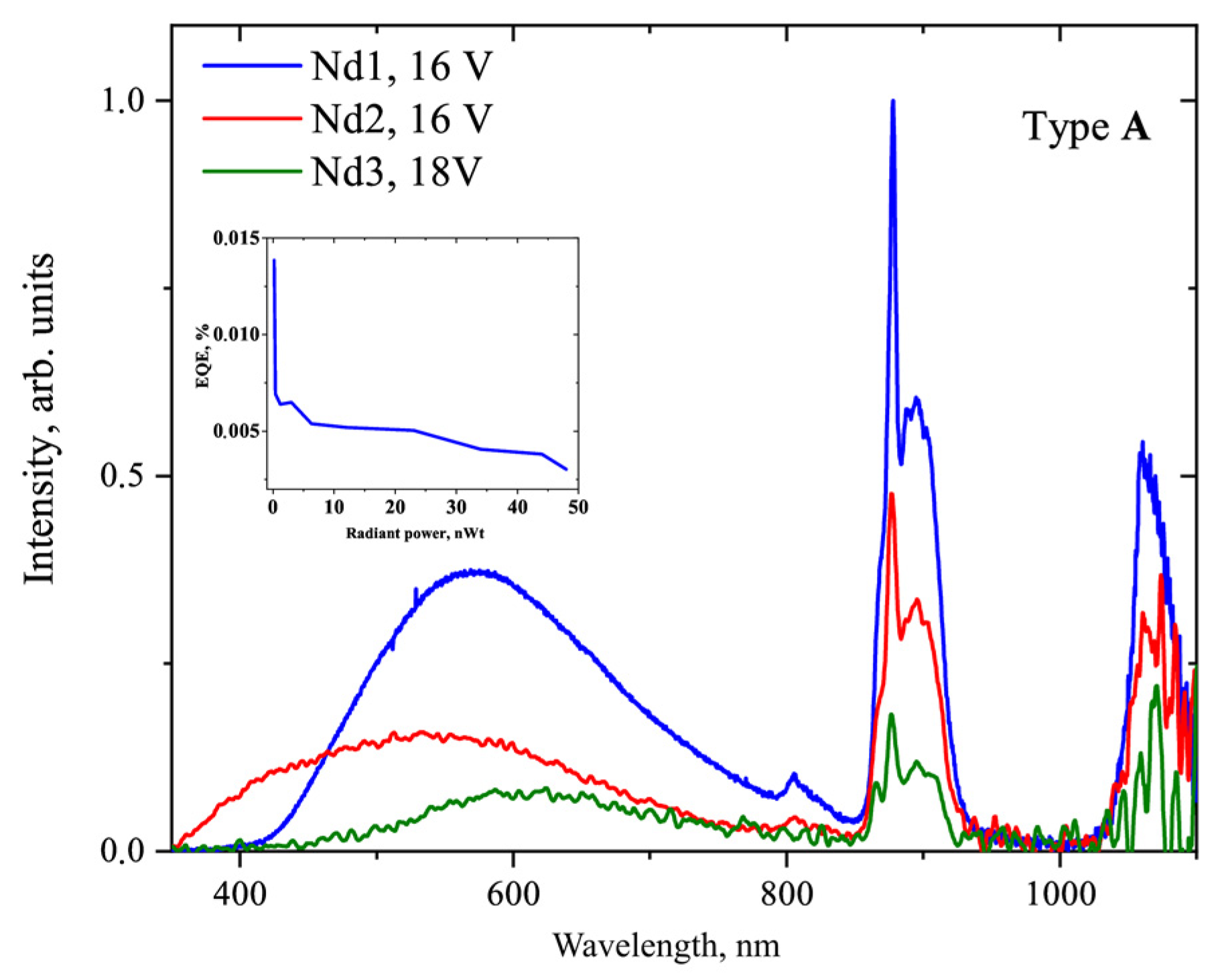OLED Structure Optimization for Pure and Efficient NIR Electroluminescence of Nd3+ Complexes Bearing Fluorinated 1,3-Diketones
Abstract
:1. Introduction
2. Materials and Methods
3. Results and Discussion
3.1. Photoluminescence Properties
3.2. Thermogravimetric Analysis (TGA) and Differential Thermal Analysis (DTA)
3.3. TD-DFT Analysis
3.4. Electrochemical Properties
3.5. Electroluminescence
3.5.1. Devices with Thermally Evaporated Layers of Nd3+ Complexes (A)
3.5.2. Devices with Spin-Coated Layers with Nd3+ Complexes (B)
4. Conclusions
Supplementary Materials
Author Contributions
Funding
Institutional Review Board Statement
Informed Consent Statement
Data Availability Statement
Conflicts of Interest
References
- Bünzli, J.-C.G.; Piguet, C. Taking advantage of luminescent lanthanide ions. Chem. Soc. Rev. 2005, 34, 1048–1077. [Google Scholar] [CrossRef]
- Lin, J.; Xu, X.; Zhou, W.; Yu, L.; Wang, Q. Easy assembly of visible light excited lanthanide containing edifices and structural origin. Dye. Pigment. 2015, 119, 56–61. [Google Scholar] [CrossRef]
- Li, J.; Li, W.; Xia, D.; Xiang, C.; Chen, Y.; Li, G. Dynamic coordination of natural amino acids-lanthanides to control reversible luminescent switching of hybrid hydrogels and anti-counterfeiting. Dye. Pigment. 2019, 166, 375–380. [Google Scholar] [CrossRef]
- Kalyani, N.T.; Dhoble, S. Organic light emitting diodes: Energy saving lighting technology—A review. Renew. Sustain. Energy Rev. 2012, 16, 2696–2723. [Google Scholar] [CrossRef]
- Bochkarev, M.N.; Pushkarev, A.P. Synthesis and luminescence of some rare earth metal complexes. Org. Photon-Photovoltaics 2016, 4, 60–67. [Google Scholar] [CrossRef]
- Taydakov, I.V.; Akkuzina, A.A.; Avetisov, R.I.; Khomyakov, A.V.; Saifutyarov, R.R.; Avetissov, I.C. Effective electroluminescent materials for OLED applications based on lanthanide 1.3-diketonates bearing pyrazole moiety. J. Lumin. 2016, 177, 31–39. [Google Scholar] [CrossRef]
- Li, Z.; Zhang, H.; Yu, J. Near-infrared electroluminescence from double-emission-layers devices based on Ytterbium (III) complexes. Thin Solid Films 2012, 520, 3663–3667. [Google Scholar] [CrossRef]
- Bünzli, J.-C.G.; Eliseeva, S.V. Lanthanide NIR luminescence for telecommunications, bioanalyses and solar energy conversion. J. Rare Earths 2010, 28, 824–842. [Google Scholar] [CrossRef]
- Sun, L.; Yu, J.; Zheng, G.; Zhang, H.; Meng, Q.; Peng, C.; Fu, L.; Liu, F.; Yu, Y. Syntheses, Structures and near-ir luminescent studies on ternary lanthanide (ErIII, HoIII, YbIII, NdIII) complexes containing 4,4,5,5,6,6,6-heptafluoro-1-(2-thienyl) hexane-1,3-dionate. Eur. J. Inorg. Chem. 2006, 2006, 3962–3973. [Google Scholar] [CrossRef]
- Katkova, M.A.; Pushkarev, A.P.; Balashova, T.V.; Konev, A.N.; Fukin, G.K.; Ketkov, S.Y.; Bochkarev, M.N. Near-infrared electroluminescent lanthanide [Pr(iii), Nd(iii), Ho(iii), Er(iii), Tm(iii), and Yb(iii)] N,O-chelated complexes for organic light-emitting devices. J. Mater. Chem. 2011, 21, 16611–16620. [Google Scholar] [CrossRef]
- Wang, L.; Zhao, Z.; Wei, C.; Wei, H.; Liu, Z.; Bian, Z.; Huang, C. Review on the electroluminescence study of lanthanide complexes. Adv. Opt. Mater. 2019, 7, 1801256. [Google Scholar] [CrossRef]
- Chi, Y.; Chang, T.-K.; Ganesan, P.; Rajakannu, P. Emissive bis-tridentate Ir(III) metal complexes: Tactics, photophysics and applications. Co-ord. Chem. Rev. 2017, 346, 91–100. [Google Scholar] [CrossRef]
- Reddy, M.; Bejoymohandas, K. Evolution of 2,3′-bipyridine class of cyclometalating ligands as efficient phosphorescent iridium(III) emitters for applications in organic light emitting diodes. J. Photochem. Photobiol. C Photochem. Rev. 2016, 29, 29–47. [Google Scholar] [CrossRef]
- Li, Y.; Liu, J.-Y.; Zhao, Y.-D.; Cao, Y.-C. Recent advancements of high efficient donor–acceptor type blue small molecule applied for OLEDs. Mater. Today 2017, 20, 258–266. [Google Scholar] [CrossRef]
- Minotto, A.; Bulut, I.; Rapidis, A.G.; Carnicella, G.; Patrini, M.; Lunedei, E.; Anderson, H.L.; Cacialli, F. Towards efficient near-infrared fluorescent organic light-emitting diodes. Light. Sci. Appl. 2021, 10, 18. [Google Scholar] [CrossRef]
- Xin, L.; Xue, J.; Lei, G.; Qiao, J. Efficient near-infrared-emitting cationic iridium complexes based on highly conjugated cyclometalated benzo[g]phthalazine derivatives. RSC Adv. 2015, 5, 42354–42361. [Google Scholar] [CrossRef]
- Latva, M.; Takalo, H.; Mukkala, V.-M.; Matachescu, C.; Rodríguez-Ubis, J.C.; Kankare, J. Correlation between the lowest triplet state energy level of the ligand and lanthanide(III) luminescence quantum yield. J. Lumin. 1997, 75, 149–169. [Google Scholar] [CrossRef]
- Kawamura, Y.; Wada, Y.; Hasegawa, Y.; Iwamuro, M.; Kitamura, T.; Yanagida, S. Observation of neodymium electroluminescence. Appl. Phys. Lett. 1999, 74, 3245–3247. [Google Scholar] [CrossRef]
- O’Riordan, A.; Van Deun, R.; Mairiaux, E.; Moynihan, S.; Fias, P.; Nockemann, P.; Binnemans, K.; Redmond, G. Synthesis of a neodymium-quinolate complex for near-infrared electroluminescence applications. Thin Solid Films 2008, 516, 5098–5102. [Google Scholar] [CrossRef]
- Shahalizad, A.; Kim, D.-H.; Bobbara, S.R.; Tsuchiya, Y.; D’Aléo, A.; Andraud, C.; Ribierre, J.-C.; Nunzi, J.-M.; Adachi, C. Enhanced near-infrared electroluminescence from a neodymium complex in organic light-emitting diodes with a solution-processed exciplex host. Appl. Phys. Lett. 2019, 114, 033301. [Google Scholar] [CrossRef]
- Shahalizad, A.; D’Aléo, A.; Andraud, C.; Sazzad, M.H.; Kim, D.-H.; Tsuchiya, Y.; Ribierre, J.-C.; Nunzi, J.-M.; Adachi, C. Near infrared electroluminescence from Nd(TTA) 3 phen in solution-processed small molecule organic light-emitting diodes. Org. Electron. 2017, 44, 50–58. [Google Scholar] [CrossRef]
- Glover, P.B.; Bassett, A.P.; Nockemann, P.; Kariuki, B.M.; Van Deun, R.; Pikramenou, Z. Fully Fluorinated imidodiphosphinate shells for visible- and NIR-emitting lanthanides: Hitherto unexpected effects of sensitizer fluorination on lanthanide emission properties. Chem.–A Eur. J. 2007, 13, 6308–6320. [Google Scholar] [CrossRef] [PubMed]
- Varaksina, E.; Taydakov, I.; Ambrozevich, S.; Selyukov, A.; Lyssenko, K.; Jesus, L.; Freire, R. Influence of fluorinated chain length on luminescent properties of Eu3+ β-diketonate complexes. J. Lumin. 2018, 196, 161–168. [Google Scholar] [CrossRef]
- Korshunov, V.; Ambrozevich, S.; Taydakov, I.; Vashchenko, A.; Goriachiy, D.; Selyukov, A.; Dmitrienko, A. Novel β-diketonate complexes of Eu3+ bearing pyrazole moiety for bright photo- and electroluminescence. Dye. Pigment. 2018, 163, 291–299. [Google Scholar] [CrossRef]
- Bünzli, J.-C.G. On the design of highly luminescent lanthanide complexes. Coord. Chem. Rev. 2015, 293–294, 19–47. [Google Scholar] [CrossRef]
- Korshunov, V.M.; Chmovzh, T.N.; Knyazeva, E.A.; Taydakov, I.V.; Mikhalchenko, L.V.; Varaksina, E.A.; Saifutyarov, R.S.; Avetissov, I.C.; Rakitin, O.A. A novel candle light-style OLED with a record low colour temperature. Chem. Commun. 2019, 55, 13354–13357. [Google Scholar] [CrossRef]
- Metlin, M.T.; Goryachii, D.O.; Aminev, D.F.; Datskevich, N.P.; Korshunov, V.M.; Metlina, D.A.; Pavlov, A.A.; Mikhalchenko, L.V.; Kiskin, M.A.; Garaeva, V.V.; et al. Bright Yb3+ complexes for efficient pure near-infrared OLEDs. Dye. Pigment. 2021, 195, 109701. [Google Scholar] [CrossRef]
- Duan, L.; Hou, L.; Lee, T.-W.; Qiao, J.; Zhang, D.; Dong, G.; Wang, L.; Qiu, Y. Solution processable small molecules for organic light-emitting diodes. J. Mater. Chem. 2010, 20, 6392–6407. [Google Scholar] [CrossRef]
- Lee, T.-W.; Noh, T.; Shin, H.-W.; Kwon, O.; Park, J.-J.; Choi, B.-K.; Kim, M.-S.; Shin, D.W.; Kim, Y.-R. Characteristics of solution-processed small-molecule organic films and light-emitting diodes compared with their vacuum-deposited counterparts. Adv. Funct. Mater. 2009, 19, 1625–1630. [Google Scholar] [CrossRef]
- Li, S.; Zhou, L.; Zhang, H. Investigation progresses of rare earth complexes as emitters or sensitizers in organic light-emitting diodes. Light. Sci. Appl. 2022, 11, 177. [Google Scholar] [CrossRef]
- Metlina, D.A.; Metlin, M.T.; Ambrozevich, S.A.; Selyukov, A.S.; Datskevich, N.P.; Aminev, D.F.; Goryachii, D.O.; Lyssenko, K.A.; Pavlov, A.A.; Dmitrienko, A.O.; et al. Bright NIR-luminescent Nd3+ complexes with pyrazole-substituted 1,3-diketones demonstrated an unusual spectral lines branching ratios. Dye. Pigment. 2020, 181, 108558. [Google Scholar] [CrossRef]
- Taydakov, I.V.; Krasnoselsky, S.S. Modified method for the synthesis of isomeric N-substituted (1H-pyrazolyl)propane-1,3-diones. Chem. Heterocycl. Compd. 2011, 47, 695–699. [Google Scholar] [CrossRef]
- Frisch, M.J.; Trucks, G.W.; Schlegel, H.B. Gaussian 16 Revision A.03. 2016. Available online: https://gaussian.com/gaussian16/ (accessed on 4 December 2022).
- Willauer, A.R.; Palumbo, C.T.; Fadaei-Tirani, F.; Zivkovic, I.; Douair, I.; Maron, L.; Mazzanti, M. Accessing the +IV oxidation state in molecular complexes of praseodymium. J. Am. Chem. Soc. 2020, 142, 5538–5542. [Google Scholar] [CrossRef]
- Maron, L.; Eisenstein, O. Do f electrons play a role in the lanthanide−ligand bonds? A DFT study of Ln(NR2)3; R = H, SiH3. J. Phys. Chem. A 2000, 104, 7140–7143. [Google Scholar] [CrossRef]
- Ahmed, Z.; Iftikhar, K. Variant coordination sphere, for efficient photo- and electroluminescence of 0.4–1.8 μm, of lanthanide(III) complexes containing a β-diketone ligand with low vibrational frequency C–F bonds and a flexible 2,2′-bipyridine ligand. Polyhedron 2015, 85, 570–592. [Google Scholar] [CrossRef]
- Wartenberg, N.; Raccurt, O.; Bourgeat-Lami, E.; Imbert, D.; Mazzanti, M. Multicolour optical coding from a series of luminescent lanthanide complexes with a unique antenna. Chem.–A Eur. J. 2013, 19, 3477–3482. [Google Scholar] [CrossRef] [PubMed]
- Yang, L.; Gong, Z.; Nie, D.; Lou, B.; Bian, Z.; Guan, M.; Huang, C.; Lee, H.J.; Baik, W.P. Promoting near-infrared emission of neodymium complexes by tuning the singlet and triplet energy levels of β-diketonates. New J. Chem. 2006, 30, 791–796. [Google Scholar] [CrossRef]
- Cardona, C.M.; Li, W.; Kaifer, A.E.; Stockdale, D.; Bazan, G.C. Electrochemical considerations for determining absolute frontier orbital energy levels of conjugated polymers for solar cell applications. Adv. Mater. 2011, 23, 2367–2371. [Google Scholar] [CrossRef]
- Hebner, T.R.; Wu, C.C.; Marcy, D.; Lu, M.H.; Sturm, J.C. Ink-jet printing of doped polymers for organic light emitting devices. Appl. Phys. Lett. 1998, 72, 519–521. [Google Scholar] [CrossRef]
- Yin, Y.; Deng, Z.; Lü, Z.; Li, X.; Li, M.; Liu, B.; Wang, Y.; Teng, F. Electroluminescent properties of poly[N,N′-bis(4-butylphenyl)-N,N′-bis(phenyl)benzidine] doped with 1,3,5-Tris(1-phenyl-1H-benzimidazol-2-yl)benzene. Displays 2015, 38, 32–37. [Google Scholar] [CrossRef]
- Jou, J.-H.; Kumar, S.; Fang, P.-H.; Venkateswararao, A.; Thomas, K.R.J.; Shyue, J.-J.; Wang, Y.-C.; Li, T.-H.; Yu, H.-H. Highly efficient ultra-deep blue organic light-emitting diodes with a wet- and dry-process feasible cyanofluorene acetylene based emitter. J. Mater. Chem. C 2015, 3, 2182–2194. [Google Scholar] [CrossRef]
- Chen, X.; Yan, R.; Zhang, W.; Fan, J. Carrier recombination spatial transfer by reduced potential barrier causes blue/red switchable luminescence in C8 carbon quantum dots/organic hybrid light-emitting devices. APL Mater. 2016, 4, 046102. [Google Scholar] [CrossRef]
- Sano, T.; Fujita, M.; Fujii, T.; Hamada, Y.; Shibata, K.; Kuroki, K.K.K. Novel europium complex for electroluminescent devices with sharp red emission. Jpn. J. Appl. Phys. 1995, 34, 1883. [Google Scholar] [CrossRef]
- Katkova, M.A.; Burin, M.E.; Logunov, A.; Ilichev, V.; Konev, A.N.; Fukin, G.K.; Bochkarev, M. Lanthanide imidodiphosphinate complexes: Synthesis, structure and new aspects of electroluminescent properties. Synth. Met. 2009, 159, 1398–1402. [Google Scholar] [CrossRef]
- Noda, T.; Ogawa, H.; Shirota, Y. A blue-emitting organic electroluminescent device using a novel emitting amorphous molecular material, 5,5’-Bis(dimesitylboryl)-2,2’-bithiophene. Adv. Mater. 1999, 11, 283–285. [Google Scholar] [CrossRef]
- Kawamura, Y.; Wada, Y.; Yanagida, S. Near-infrared photoluminescence and electroluminescence of neodymium (III), erbium (III), and ytterbium (III) complexes. Jpn. J. Appl. Phys. 2001, 40, 350. [Google Scholar] [CrossRef]









| T1, Triplet State, nm/cm−1 | Method | Major Contribution |
|---|---|---|
| 449/22271 | TD | HOMO-2- > LUMO+2 (42%) HOMO-3- > LUMO+4 (19%) |
| 433/23095 | TDA | HOMO-2- > LUMO+2 (44%) HOMO-3- > LUMO+4 (20%) |
| Sample | Eredonset, V | Eoxonset, V | ELUMO, eV | EHOMO, eV | Eg, eV |
|---|---|---|---|---|---|
| Nd1 | −1.46 | 1.2 | −3.15 | −5.81 | 2.66 |
| Nd2 | −1.42 | 0.89 | −3.18 | −5.49 | 2.31 |
| Nd3 | −1.37 | 0.94 | −3.23 | −5.54 | 2.31 |
Disclaimer/Publisher’s Note: The statements, opinions and data contained in all publications are solely those of the individual author(s) and contributor(s) and not of MDPI and/or the editor(s). MDPI and/or the editor(s) disclaim responsibility for any injury to people or property resulting from any ideas, methods, instructions or products referred to in the content. |
© 2023 by the authors. Licensee MDPI, Basel, Switzerland. This article is an open access article distributed under the terms and conditions of the Creative Commons Attribution (CC BY) license (https://creativecommons.org/licenses/by/4.0/).
Share and Cite
Metlina, D.A.; Goryachii, D.O.; Metlin, M.T.; Mikhalchenko, L.V.; Korshunov, V.M.; Taydakov, I.V. OLED Structure Optimization for Pure and Efficient NIR Electroluminescence of Nd3+ Complexes Bearing Fluorinated 1,3-Diketones. Materials 2023, 16, 1243. https://doi.org/10.3390/ma16031243
Metlina DA, Goryachii DO, Metlin MT, Mikhalchenko LV, Korshunov VM, Taydakov IV. OLED Structure Optimization for Pure and Efficient NIR Electroluminescence of Nd3+ Complexes Bearing Fluorinated 1,3-Diketones. Materials. 2023; 16(3):1243. https://doi.org/10.3390/ma16031243
Chicago/Turabian StyleMetlina, Daria A., Dmitry O. Goryachii, Mikhail T. Metlin, Lyudmila V. Mikhalchenko, Vladislav M. Korshunov, and Ilya V. Taydakov. 2023. "OLED Structure Optimization for Pure and Efficient NIR Electroluminescence of Nd3+ Complexes Bearing Fluorinated 1,3-Diketones" Materials 16, no. 3: 1243. https://doi.org/10.3390/ma16031243
APA StyleMetlina, D. A., Goryachii, D. O., Metlin, M. T., Mikhalchenko, L. V., Korshunov, V. M., & Taydakov, I. V. (2023). OLED Structure Optimization for Pure and Efficient NIR Electroluminescence of Nd3+ Complexes Bearing Fluorinated 1,3-Diketones. Materials, 16(3), 1243. https://doi.org/10.3390/ma16031243







